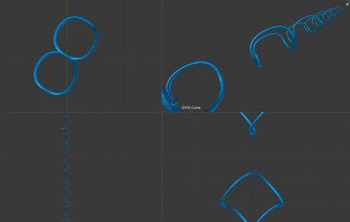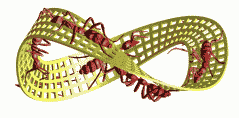A short animated-gif of the upwards spiraling figure 8 particle, from the older high res Screencast-movie that I mention in 'About Me' on the side (movie - 40Mb) ... and what this project is about.
Similar to Professor Oscar Velasco Fuentes' knotted filamentary-vortex:
The final goal is to get this action 'naturally' going within a gas made out of frictionless (ellipsoidal) particles, wherein these of loops automatically would emerge thanks to the right destiny and velocity of the particles that make up the medium. Check the iPhone physics-app 'Liquid' to get an impression of such a gas: https://itunes.apple.com/en/app/liquid-dynamics/id417814216?mt=8. When you adjust the settings you get a medium where continuously semi-vortices pop up (see pic.):
Note: If you haven’t got an iPhone you could check this Java-applet made by Grant Kot: http://grantkot.com/MPM/Liquid.html The iPhone ‘Liquid' App is based on this Java-applet and is roughly the same. In the image below are the settings (upper line-table only blue-green) to get the similar semi-vortices that quickly come an go in and out of existence (note on the iPhone app it’s slightly more intenser and more pronounced), and you need to play with it for a couple of seconds and wait a little to let the gas stabilize ...
... but these semi-vortices are unstable and come and go into existence, so that's why the idea surfaced to use slippery 0val-bodies instead of the 'classic' spherical point-particles; and because these 0val-particles interact in a unique way, with the path that redirects them again along their central-axis, they might a that extra ingredient to the medium, whereby some of these semi-vortices are replaced by vortices that are stable, and take on a steady / solid form within the medium, a bit like how these kids form a closed loop (Ouroboros):







































